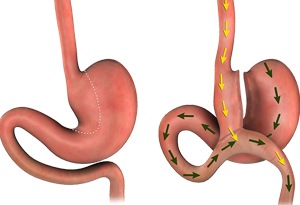
Introduction
Gastric bypass, also known as Roux-en-Y gastric bypass, is a bariatric or weight loss surgery for obese patients who have not been successful losing weight through dieting, exercise, and medication.
The surgery uses a combination of restrictive and malabsorptive techniques to achieve a successful outcome. Staples are used to create a smaller stomach to limit the amount of food intake, and a large portion of the small intestine is bypassed to limit the nutrients and calories absorbed.
The goal of the surgery is to make you feel full quicker so you don’t overeat, and absorb fewer calories by the modifications made in the small intestine.
Gastric bypass surgery has been shown to help reduce obesity and related illnesses, including heart disease, high blood pressure, and especially type 2 diabetes.
It can be performed laparoscopically through tiny incisions (minimally invasive technique) or through a large open incision (open technique).
Disease Overview
Obesity is a chronic condition in which there is an excessive accumulation of fat in the body.
Obesity is defined as a Body Mass Index (BMI) of 30 to 34.9 and extreme obesity is a BMI of 40 or more. When a person’s BMI is 50 or higher, it is referred to as super obesity.
Obesity is a global problem affecting people of almost all age groups and is associated with a greatly increased risk of chronic diseases.
Indications
Gastric Bypass surgery may be recommended when diet, exercise or medications have not helped in reducing your weight.
It is indicated for people with a BMI of 40 or more, and also in those whose BMI is 35 to 39 that are suffering from obesity-associated health conditions such as:
- Type 2 diabetes
- Heart disease
- High blood pressure
- High cholesterol
- Sleep apnea
- Nonalcoholic fatty liver disease
- Cancer
Surgery
Gastric bypass surgery is performed under general anesthesia. Your surgeon makes several small incisions on your abdomen. A laparoscope, a thin instrument with a light and camera on the end, is inserted through one of the incisions, allowing your surgeon to clearly view the internal organs on a monitor. Small surgical instruments are inserted through the other incisions to perform the surgery.
The first step is to reduce the size of the stomach so that it holds less food. The upper portion of the stomach near the esophagus is converted into a pouch by stapling.
The second step of the surgery involves the creation of a bypass for food to flow from the new stomach pouch. The small intestine is divided into upper and lower segments. The lower segment of the small intestine (jejunum) is connected to the new pouch, while the upper segment (duodenum) is stapled closed. At the end of the procedure, the incisions are closed with sutures.
Postoperative Care
After gastric bypass surgery, you will have to stay in the hospital for about 3 to 5 days.
Your doctor will prescribe pain-relieving medications to keep you comfortable. You will be given instructions to follow regarding wound care, diet, and activity such as:
- Keep the incision area clean and dry.
- Avoid strenuous exercises and lifting heavyweights
- You may not be able to eat food for the first 1 to 3 days, after which you will be put on a liquid diet followed by pureed or soft foods.
- Sip water throughout the day to prevent dehydration.
- Follow the diet regimen given to you by the dietician.
- Follow an exercise program per your surgeon’s instructions to maintain weight loss.
Advantages and Disadvantages
Gastric bypass surgery can help you lose about 10 to 20 pounds a month in the first year following surgery. You will gradually lose more weight by eating a healthy diet and participating in regular exercise. The surgery also helps you manage obesity-related health conditions.
However, lifelong follow-up with a physician is required for blood tests to ensure proper health and nutrition.
In rare cases, if for any reason a patient needs to have the operation reversed, the stomach is still there and can be hooked up again. This remnant stomach can also be used to help feeding if an unrelated serious medical problem should occur.
Risks and Complications
As with any surgery, there are potential risks and complications involved. Complications associated with Gastric Bypass include:
- Problems associated with anesthesia
- Bleeding
- Infection
- Bowel obstruction
- Leaks in your gastrointestinal tract
- Deep vein thrombosis (blood clot in the leg)
- Dumping syndrome leading to diarrhea and nausea
- Hernia
- Gallstones
- Malnutrition
- Ulcers
Summary
Gastric Bypass surgery is an effective procedure to treat obesity, one of the leading causes of preventable death worldwide. The goal of surgery is to lose large amounts of weight by making you feel full quicker with less food, thereby limiting your calorie intake, and absorb fewer calories by the modifications made in the small intestine.
The rate of weight loss and outcome of the surgery varies depending on the patient’s post-surgical eating habits and exercise. Success is possible when patients commit to changing their lifestyle habits and have regular follow-up doctor visits.














